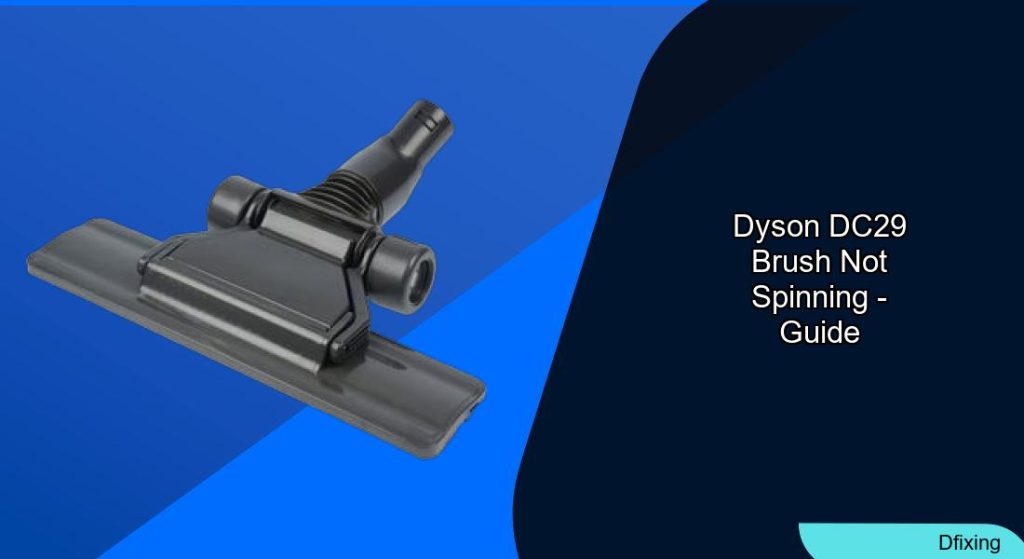A malfunctioning brush roll in your Dyson DC29 vacuum can turn routine cleaning into a frustrating chore, especially if you’re dealing with pet hair or carpets. This issue often stems from preventable causes like tangled debris, worn components, or mechanical failures. By following a structured approach, you can diagnose and resolve the problem without professional help. This guide provides actionable steps, from basic maintenance to advanced troubleshooting, ensuring your vacuum regains its peak performance.
Affiliate disclosure: As an Amazon associate, We'll earn a commission for every successful order through our affiliate links in the article. However, you won’t be charged anything for this.
The article covers common causes of a stationary brush roll, detailed cleaning techniques, part replacements, and maintenance routines. Whether the issue lies in a frayed belt, clogged brush, or electrical fault, you’ll find tailored solutions to address each scenario. Additionally, we’ll highlight best practices to extend your Dyson DC29’s lifespan and prevent recurring issues.
Common Causes of a Non-Spinning Brush
Tangled Hair and Debris
Hair, threads, or small objects often wrap around the brush roll, creating friction that halts its rotation. Inspect the roller for visible obstructions and use scissors or a razor blade to cut away tangles. Regular post-use cleaning prevents debris buildup.
Worn or Damaged Bristles
Over time, bristles fray, shorten, or break off, reducing the brush’s effectiveness. Check for uneven wear or missing sections. Replace the roller brush if the damage is severe.
Broken or Stretched Belt
The belt connects the motor to the brush roll. Cracks, breaks, or excessive slack in the belt disrupt power transfer. Inspect the belt monthly and replace it if worn or misaligned.
Internal Fluff Buildup
Accumulated dust and fibers inside the vacuum head can jam the brush mechanism. Disassemble the housing to remove fluff and debris during routine maintenance.
Step-by-Step Guide to Fixing the Brush
Disassemble the Vacuum Head
- Safety First: Unplug the vacuum and turn it off.
- Detach the Powerhead: Press the release button or lever to separate the head from the main unit.
- Remove Housing Screws: Use a screwdriver to open the roller brush housing. Carefully lift the cover to access the brush roll.
Clean and Inspect the Roller Brush
- Remove Debris: Cut tangled hair or threads from the brush using scissors. Clear remaining particles with a cleaning brush or fingers.
- Assess Bristles: Replace the roller brush if bristles are frayed or missing.
Replace the Belt
- Check the Belt: Look for cracks or slack. If damaged, loosen the tension and remove the old belt.
- Install a New Belt: Loop the replacement belt around the motor shaft and brush roll. Ensure it’s taut and properly seated.
Reassemble and Test
- Reinsert the Brush: Align it with the belt and secure the housing cover with screws.
- Reattach the Powerhead: Snap it back into place.
- Test the Vacuum: Turn it on and confirm the brush spins freely. Perform a carpet cleaning test to ensure optimal suction.
Advanced Troubleshooting Techniques
Motor and Belt Inspection
If the brush spins only when the head is upside-down, the motor may be faulty.
1. Divide the Head: Unscrew the casing to access the motor.
2. Test Continuity: Use a multimeter to check the motor. Replace it if no power flows through.
Wiring Issues
Intermittent spinning suggests loose connections.
1. Inspect Terminals: Check for damaged wires or disconnected terminals inside the brush head.
2. Repair Connections: Reattach loose wires or replace frayed cables.
Battery and Reset Switch Problems
A weak battery or faulty reset switch can cause sudden stoppage.
1. Charge the Battery: Ensure it delivers full power. Replace if necessary.
2. Check the Reset Switch: Located near the switch housing, reseat or replace it if jammed.
Maintenance Tips for Longevity
Prevent Tangles
Clean the brush roll after each use with a dedicated hair-removal tool. This prevents debris accumulation and extends its lifespan.
Monthly Belt Checks
Inspect the belt for cracks or stretching. Replace it every 6–12 months, depending on usage.
Lubricate Bearings
Apply a small amount of silicone-based lubricant or Vaseline to the brush roll bearings. This reduces friction and ensures smooth rotation.
General Care
Empty the dust bin regularly to maintain suction power. Store the vacuum in a dry, dust-free area to avoid moisture damage.
Frequently Asked Questions (FAQ)
How often should I replace the Dyson DC29’s belt?
Replace the belt every 6–12 months or immediately if cracked or loose. Regular checks prevent sudden breakdowns.
Why does my brush roll stop after a few seconds?
This often points to a faulty battery, wiring issue, or reset switch malfunction. Test each component to identify the cause.
Can I clean the brush roll without tools?
Yes, manually remove large debris and use a damp cloth for fine particles. For tangled hair, scissors or a razor blade are recommended.
What lubricant should I use for the bearings?
Use silicone-based lubricants or Vaseline. Avoid oil-based products, which can attract dust.
How do I test the reset switch?
Unplug the vacuum, locate the switch near the housing, and check for jams. Reseat or replace it if necessary.
Conclusion
A Dyson DC29 brush not spinning is a solvable issue with the right approach. Start by addressing simple fixes like debris removal or belt replacement before moving to advanced troubleshooting. Regular maintenance—cleaning the brush roll, lubricating bearings, and inspecting parts—can prevent future problems.
If mechanical or electrical failures persist, replacement components like the belt, motor, or reset switch are available through Dyson or authorized dealers. By following these steps, you’ll restore your vacuum’s performance and keep your home spotless with minimal hassle.







